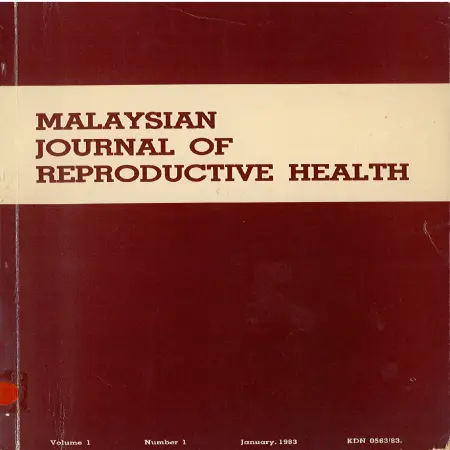Browse by Year
Results for Year : "1983"
1983 (8)
|
|
Malaysian Journal of Reproductive Health (Volume 1, Number 1, January 1983)
Item Type: Book
Editor:
Year: 00/01/1983
Abstract: An official publication of Reproductive Research Centre, National Family Planning Board, Malaysia, in collaboration with the Malaysian Association of maternal and Neonatal Health.
|
|
|
|
|
|
Age of biological maturity of Malaysian girls by ethnicity
Item Type: Article
Editor:
Year: 00/01/1983
Abstract: This study tries to estimate the age of biological maturity of Malaysian girls by ethnicity by employing an indirect methodology. Age at biological maturity is estimated by considering retrospective fertility and family survey data on marriage, first birth, and contraceptive use. The waiting time for the biological mature females to conceive is 3.0 months; 3.2 months among the Malays, 2.7 months among the Chinese, and 2.8 months among the Indians.The maximum age of attaining biological maturity is 20 for all ethnic groups except Indians (19 years). The expected age biological maturity at birth is 15.6 years; 15.3 years for the Malays, 15.4 for the Chinese and 14.8 years for the Indians.The mean age of attaining biological maturity coincides with the expected age of attaining biological maturity at birth.
|
|
|
|
|
|
Determinants of neonatal outcome in a Malaysian Maternity Hospital, 1980-1981
Item Type: Article
Editor:
Year: 00/01/1983
Abstract: The compilation and analysis of basic perinatal statistics in the Maternity Hospital, Kuala Lumpur is described. The study period covers the years 1980-1981. Determinants of neonatal mortality include very low birthweight (<1.5 kg), a gestational age of less than 32 weeks and clinical conditions of asphyxia, bacterial sepsis and respiratory distress syndrome. A proposal for a clinical classification of neonatal mortality is advanced and implications for a wider applicability of this approach is suggested to better evaluate perinatal performance in hospitals all over the country.
|
|
|
|
|
|
The pattern of maternal mortality at Maternity Hospital Kuala Lumpur
Item Type: Article
Editor:
Year: 00/01/1983
Abstract: From 1978 to 1981, there were 70,000 deliveries at Maternity Hospital, Kuala Lumpur. 39 maternal mortalities were encountered during this four year period. The major causes of death were toxemia, hemorrhage, embolism, medical disease in pregnancy, sepsis, uterine inversion, obstetric trauma, Mendelson and pulmonary edema. Avoidable factors were isolated in all the mortalities except in three, one due to infective hepatitis and two due to cardiac disease in pregnancy. The patient was at fault in four mortalities. The need for documenting all maternal mortalities is a priority in this country to make analysis more meaningful.
|
|
|
|
|
|
Office laparoscopic assessment of female fertility
Item Type: Article
Editor:
Year: 00/01/1983
Abstract: The preliminary report details our experience and also serves to evaluate the risk benefits of office laparoscopy for female fertility assessment in 183 subjects. The patients were admitted at about 8.00 in the morning and discharged at 3.00 to 4.00 in the afternoon after laparoscopy has been performed. Only 7.7 percent of the subjects required inhalational anesthetic gases along with a combination of intravenous sedation and local anesthetic infiltration. The pick-up rate for pelvic abnormality is fairly high, approximately 22.4 percent. Difficulties and complications encountered during laparoscopy were minimal and easily overcome.The benefits of laparoscopy overrules assessment and sterilization feature laparoscopy on an 'outpatient basis' as one of its main activities.
|
|
|
|
|
|
Actinomyces-like organisms in the cervical smears of IUCD users
Item Type: Article
Editor:
Year: 00/01/1983
Abstract: Cervical smears of 128 intrauterine contraceptive device users were stained by Gram stain and screened for the presence of Actinomyces-like organisms. Actinomyces-like organisms were observed in 5.5 percent, pus cell in 20.1 percent and yeast cells in 10.2 percent of the smears examined. The average duration of insertion was 8 months. Smears of 103 controls were negative for Actinomyces-like organisms, pus cells were observed in 8.7 percent and yeasts in 4.8 percent.
|
|
|
|
|
|
Problems of neonatal surgery in Malaysia
Item Type: Article
Editor:
Year: 00/01/1983
Abstract: From January 1970 to May 1981, there were 594 neonates admitted to the General Hospital, Kuala Lumpur for surgery. Three hundred and seventy-one cases bad major alimentary tract alimentary tract abnormalities 97.1 percent of which caused obstruction. High gut anomalies and diaphragmmatic hernia (Group A cases) were relatively uncommon and the overall post-operative mortality for this group was high (64.6 percent). Overall mortality declined from 75.0 percent in 1970 to 10.3 percent for the first six month of 1981. Death rate among the low birth weight infants and those with multiple anomalies however, remain high. Factors related to post-operative mortality are discussed. Foremost among them is the time of referral to the surgeon. Various problems of management in this hospital are also highlighted.
|
|
|
|
|
|
Female sterilization using filshie clip in private practice
Item Type: Article
Editor:
Year: 00/01/1983
Abstract: The findings of a trial clip female sterilization program in private practice in Malaysia is presented. The Filshie clips were successfully applied in 382 subjects. Complications encountered were minimal. Only one subject presented with an intrauterine pregnancy following sterilization (0.3 percent). The success rate was very high in the region of 99.7 percent. This study also strengthens the view that private practitioners can play a very important role in the delivery of family planning advice and services to the masses in developing countries.
|
|
|
|












